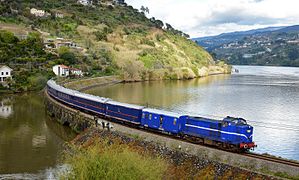Comboio Presidencial
| Comboio Presidencial | |
|---|---|
|
The Comboio Presidencial in 2016, pulled by a class 1400 locomotive on the Linha do Douro
|
|
| Manufacturer: | various |
| Year of construction (s): | 1910, processing 2009-13 |
| Retirement: | until 1970; in operation again since 2016 |
| Gauge : | 1668 mm |
The Comboio Presidencial , in German "Presidential Train", is a Portuguese historical train that was intended exclusively for the transport of the Portuguese presidents between 1910 and 1970 . After a thorough overhaul between 2009 and 2013, the train now runs for tourist purposes. It is owned by the Portuguese National Railway Museum .
history
Commissioning and traffic until 1970
The Portuguese state railways ( Caminhos de Ferro Portugueses ) began the special service of the presidential train in 1910, after Portugal abolished the monarchy and declared itself a republic in the same year. Before that, various Portuguese kings used the Portuguese railways for transportation within continental Portugal. The train was not only used by the Portuguese presidents but also by senior government ministers.
The first wagons on the train were originally purchased for the royal family in 1890 and were used in almost unchanged form until around 1940. It was not until 1930 that the state railroad bought a lounge car from the manufacturer Linke-Hoffmann-Busch in order to offer the President a higher level of comfort. Around 1940, the other cars are said to have been adapted to the style of the saloon car.
The train was one of the most popular modes of transport used by the Portuguese presidents - such as Óscar Fragoso Carmona , Craveiro Lopes and Américo Tomás . Despite the relatively low speed of 100 km / h, the journey was considered comfortable and luxurious. Foreign state guests, such as Queen Elizabeth II on her state visit in 1957, also use the train. On April 28, 1957, President Américo Tomás used the Comboio Presidencial for the first trip after electrification on the suburban line from Lisbon to Sintra (" Linha de Sintra "). Tomás also used the train, for example, to meet the Spanish dictator Francisco Franco in December 1964 on the border in northern Portugal.
Between the 1940s and 1970, the Comboio Presidencial train set consisted of the following cars:
| designation | |||
| SR yf 2
(88-29 001) |
Restaurant car (Salão Restaurante) | 1890
(1940) |
Désouches David & Cie, France |
| S yf 3
(89-29 001) |
Presidential Car (Salão Presidencial) | 1890
(1941) |
Désouches David & Cie, France |
| S yf 4
(89-29 002) |
Minister Car (Salão dos Ministros) | 1890
(1940) |
Désouches David & Cie, France |
| S yf 5
(89-29 010) |
Head of Government's Car (Salão do Chefe do Estado) | 1930/1955 | Linke-Hofmann-Busch , Braunschweig, Germany |
| A 7yf 704
(17 29 001) |
Journalists' car (Salão dos Jornalistas) | 1930 | Nicaise &
Delcuve, Bruges, Belgium |
| D yf 408 | Transport trolley | 1930 | Baume & Marpent, Hainaut,
Belgium |
In 1970 the Portuguese railways put the train out of service. After the Carnation Revolution in 1974, the Portuguese presidents continued to use the railroad, but the CP provided regular cars for this.
Refurbishment 2009–2013
At the beginning of 2009 the National Railway Museum Portugal ( Museu Nacional Ferroviário ) in Entroncamento decided to have the train set completely overhauled. Such a refurbishment of old trains was unique in Portugal to date. The restoration was intended to create an atmosphere of the 1970s. The museum sought funding from various sources, including the government program “Programa Mais Centro” (QREN), funding from the national tourism association and the companies Comboios de Portugal, Rede Ferroviária Nacional, Marsipel and Somaia. The costs amounted to at least 1.25 million euros.
After almost four years of refurbishment, the train was presented to the public on December 12, 2013. The renewed “inauguration trip” took place between Lisbon's Santa Apolónia train station and Entroncamento , the seat of the Railway Museum. Since then, the train has been owned by the museum and is used as part of tourist and cultural events throughout the Portuguese railway network. The train is mostly pulled by the diesel locomotive no.1424 of the 1400 series, which is designed in the same style.
In 2017, the museum won the “world's best event” award from the Beaworld event and communication festival .
Picture gallery
Web links
- Official website (Portuguese, English)
Individual evidence
- ↑ a b c d e f g Comboio Presidencial - Projeto de conservação e restauro. Museu Nacional Ferroviário, accessed November 29, 2017 (Portuguese).
- ^ A b Carlos Cipriano: O último sobrevivente do Comboio Presidencial. In: Público. August 1, 2010. Retrieved November 29, 2017 (Portuguese).
- ^ Carlos Cipriano: O melhor evento público do mundo é português, é um comboio e circula no Douro. In: Público. November 20, 2017. Retrieved November 29, 2017 (Portuguese).






